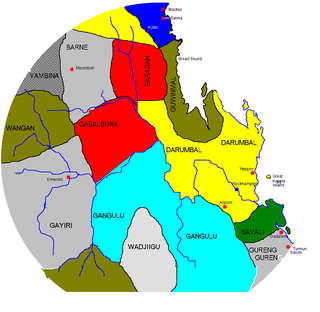The Bakanambia, also known as the Wanbara, are an Aboriginal group of Australia. Traditionally, the Bakanambia lived in the vicinity of Princess Charlotte Bay in the state of Queensland. One of the ethnonyms applied to them was Lama Lama, which is now used of a larger aggregation of remnants of several tribes.

The Narungga people, also spelt Narangga, are a group of Aboriginal Australians whose traditional lands are located throughout Yorke Peninsula, South Australia. Their traditional language, one of the Yura-Thura grouping, is Narungga.

The Barngarla, formerly known as Parnkalla and also known as Pangkala, are an Aboriginal people of the Port Lincoln, Whyalla and Port Augusta areas. The Barngarla are the traditional owners of much of Eyre Peninsula, South Australia.
Kukatj, also rendered Gugadj, is an extinct Paman language of the Cape York Peninsula, Queensland, Australia. The name Kalibamu has also been assigned to it, although this may be a separate dialect. It is spoken by the Kukatj people. A single speaker was last recorded in 1975.

Mineng, also spelled Minang or Menang or Mirnong, are an indigenous Noongar people of southern Western Australia.
The Wangaaypuwan, also known as the Wangaibon or Ngiyampaa Wangaaypuwan, are an Aboriginal Australian people who traditionally lived between Nyngan, the headwaters of Bogan Creek, and on Tigers Camp and Boggy Cowal creeks and west to Ivanhoe, New South Wales. They are a clan of the Ngiyampaa nation.
The Malyangaapa are an Indigenous Australian Tribe of people who live in the far western areas of the state of New South Wales.
The Yardliyawara, also known as the Jadliaura and variant spellings, are an Aboriginal Australian people of South Australia.
The Kaneang are an indigenous Noongar people of the south west region of Western Australia.
The Bibulman (Pibelmen) are an Aboriginal Australian people of the southwestern region of Western Australia, a subgroup of the Noongar.
The Walmbaria are an indigenous Australian people of Cape York Peninsula in northern Queensland.
The Oitbi were an indigenous Australian people of the Cobourg Peninsula of the Northern Territory.
The Wanggumara, also spelt Wangkumara, Wongkumara, Wangkumarra, and other variants, are an Aboriginal people of the state of Queensland, Australia.
The Maijabi (Mayi-Yapi) were an indigenous Australian people of the state of Queensland.

The Gayiri, people, also spelt or known as Kairi, Kararya, Kari, Khararya and Kaira, Bimurraburra, Gahrarja, Gara Gara, Ara Ara, and Kara Kara, are an Aboriginal Australian people of the state of Queensland.
The Miyan, or Mian, were an indigenous people of the state of Queensland.
The Yilba, also written Ilba and Jilba, are or were an Aboriginal Australian people of the present-day state of Queensland.
The Mingin, also known as the Mingginda, are an Aboriginal Australian people of the state of Queensland, who lived in the Gulf Country east of Moonlight Creek and the Yukulta / Ganggalidda people in the southern Gulf of Carpentaria.
The Biyaygiri, also known as Bandjin, were an Aboriginal Australian people of northern Queensland.
The Yalarnnga, also known as the Jalanga, are an Indigenous Australian people of the state of Queensland.